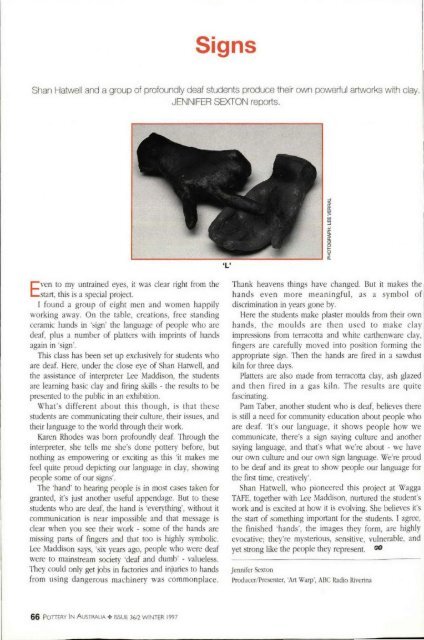Pottery In Australia Vol 36 No 2 Winter 1997
Create successful ePaper yourself
Turn your PDF publications into a flip-book with our unique Google optimized e-Paper software.
Signs<br />
Shan Hatwell and a group of profoundly deaf students produce their own powerful artworks with clay.<br />
JENNIFER SEXTON reports.<br />
Even to my untrained eyes, it was clear right from the<br />
start, this is a special project.<br />
I found a group of eight men and women happily<br />
working away. On the table, creations, free standing<br />
ceramic hands in 'sign' the language of people who are<br />
deaf, plus a number of planers with imprints of hands<br />
again in 'sign'.<br />
This class has been set up exclusively for students who<br />
are deaf. Here, under the close eye of Shan Harwell, and<br />
the assistance of interpreter Lee Maddison, the students<br />
are learning basic clay and firing skills - the results to be<br />
presented to the public in an exhibition.<br />
What 's different about this though , is tha t these<br />
students are communicating their culture, their issues, and<br />
their language to the world through their work.<br />
Karen Rhodes was born profoundly deaf. Through the<br />
inrerpreter, she tells me she's done pmtery hefore, but<br />
nothing as empowering or eXCiting as this 'it makes me<br />
feel quite proud depicting our language in clay, showing<br />
people some of our signs'.<br />
The 'hand' to hearing people is in most cases taken for<br />
gra nted, it's just another useful appendage. But to these<br />
students who are deaf, the hand is 'everything', without it<br />
communication is near impossible and that message is<br />
clear when you see their work - some of the hands are<br />
missing parts of fingers and that too is highly symbolic.<br />
Lee Maddison says, 'six years ago, people who were deaf<br />
were to mainstream society 'deaf and dumb' - valueless.<br />
They could only get jobs in factories and injuries to hands<br />
from using dangerous machinery was commonplace.<br />
'L'<br />
'----=_--' i<br />
Thank heavens things have changed. But it makes the<br />
hands even more meaningful, as a symbol ofl<br />
discrimination in years gone by.<br />
Here the students make plaster moulds from thei r own<br />
hands, the moulds are then used to make clay<br />
impressions from terracotta and white earthenware clay,<br />
fingers are carefully moved into position form ing the<br />
appropriate sign. 1hen the hands are fired in a sawdust I<br />
kiln for three days.<br />
Plancrs are also made from terracotta clay, ash glazed I<br />
and then fired in a gas kiln. The results are quite<br />
fascinating,<br />
Pam Taber, another student who is deaf, believes there<br />
is still a need for community education about people who<br />
are deaf. 'It's ou r language, it shows people how we<br />
communicate, there's a sign saying culture and another<br />
saying language, and that's what we're about - we have<br />
our own culture and our own sign language, We're proud<br />
to be deaf and its great to show people Our language for<br />
the first time, creatively'.<br />
Shan Harwell, who pioneered this project at Wagga<br />
TAPE, together with Lee Maddison, nurtured the student's<br />
work and is excited at how it is evolving. She believes it's<br />
the stan of something important for the students. I agree,<br />
the finished 'hands', the images they form , are highly<br />
evocative; they're mysteriOUS, sensitive, vulnerable, and<br />
yet strong like the people they represent. G!O<br />
Jennifer Sexton<br />
Producer/Presenler, 'Art Warp', ABC Radio Ri"erina<br />
66 POTIERY IN AUSTRAlIA + ISSUE l6f1. WlNTER <strong>1997</strong>


















